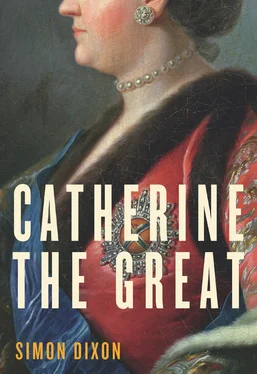Catherine was no less concerned with the reactions of a more immediate public. On top of the Kremlin ramparts, a separate troop of guardsmen wheeled into place the cannon that would proclaim crucial moments of the ceremony to an expectant crowd on Red Square. From that unpaved thoroughfare at the heart of the sprawling old capital, the throng spilled over into a maze of narrow lanes. Visiting in 1780, Joseph II of Austria found Moscow ‘much larger than anything I’ve seen. Paris, Rome, Naples, in no way approach its size’. 15Two years earlier, the British traveller Archdeacon William Coxe declared it ‘certainly the largest town in Europe, its circumference within the rampart…being exactly 39 versts or 26 miles’. 16Though contemporary estimates of the city’s population varied widely, and it fluctuated according to the season, as many as 300,000 people could cram into the city after the summer harvest. 17All of them, it seemed, had turned out to witness Catherine’s triumphal entry nine days before the coronation.
Silken carpets, draped over the balconies of the grander houses, added a splash of semi-Asiatic colour to this most verdant of cities. Even the meanest streets through which the parade passed were strewn with festive fir-branches, carved and formed into decorative trellises. 18Yet Moscow was by no means wholly synonymous with squalor. ‘Some parts of this city have the look of a sequestered desert,’ Coxe reported, ‘other quarters of a populous town, some of a contemptible village, others of a great capital’. 19Often dismissed as unplanned and unkempt by comparison with the geometrically regimented St Petersburg, the old capital could boast some impressive modern architecture of its own. The Kremlin Arsenal, begun in 1702 but completed only in 1736, was an early example of Russian classicism, the university (Russia’s first, founded in 1755), one of the most recent at the time of Catherine’s coronation. To these had been added four new triumphal arches, built by 3000 labourers under the supervision of architects working for Prince Nikita Trubetskoy’s Coronation Commission. 20Each arch featured two full-scale portraits of the empress by the Synodal artist Aleksey Antropov, and incorporated a mixture of classical and panegyric motifs chosen by Trubetskoy’s stepson Mikhail Kheraskov, the curator of Moscow University and one of the leading Russian writers of the age. 21
Nor was it only the foreign elements in Russian culture that were mobilised to welcome the new sovereign. Priests bowed from the porches of every church in the city as a carillon rang out on the eve of the second great feast in the Orthodox liturgical calendar, the Exaltation of the Life-Giving Cross. Spectators who could find a ticket or bribe the guards mounted galleries erected in all the city’s main squares to gain a better view of their empress as she swept past in an open eight-horse carriage through streets lined with cheering subjects on her way to the Nikolsky Gate. There, at the north-eastern corner of the Kremlin, Catherine was formally greeted by Metropolitan Timofey (Shcherbatsky), while a choir of students from Moscow’s Slavonic-Greek-Latin Academy, dressed in white and holding forth laurel branches, hymned God’s chosen ruler before accompanying her to a service of celebration at the Cathedral of the Dormition. ‘Sing solemnly, Russia,’ the seminarists chanted: ‘raise your voice to the heavens.’ 22
* * *
Catherine’s entry into Moscow could hardly have presented a more impressive spectacle. Behind the scenes, however, the government worried that an unprecedented influx of migrants might destabilise an already overcrowded city. The Court and all its acolytes had decamped en masse from St Petersburg, leaving the Earl of Buckinghamshire, who arrived there as the new British ambassador on 11 September, stranded without hope of reaching Moscow in time for the coronation (he had to be satisfied with the celebrations presided over by Ivan Neplyuev, the Senator left in charge of the capital in the empress’s absence). 23Already softened by the autumn rains, the roads to the old capital were ‘very bad, and the horses so much fatigued with the concourse of people who have lately travelled that way, as to make any degree of expedition impracticable’. 24Some 395 horses were required at each posting station merely to transport the 63 carriages needed by Catherine’s small entourage of 23. Since the tsarevich’s suite demanded 257 horses for 27 carriages, the Postal Chancellery took more than a month to assemble the necessary animals. By one estimate, some 19,000 horses were hired to haul the remaining notables, the wheels of their carriages splashing mud over the lines of straggling rustics, beggars and petty tradesmen who flocked to the old capital in the hope of sharing in the bounty traditionally distributed by a ‘merciful’ new monarch. In 1903, the contrast between richly attired courtiers and ragged peasants would wreck Nicholas II’s quest for national reconciliation at the canonisation of St Serafim of Sarov. Anxious to avoid any such comparison during Catherine’s coronation, her officials belatedly banned the import of fabric woven in gold and silver thread on 17 September. 25
Fears that speculators might cause unrest by artificially inflating bread prices proved unfounded. Though Moscow remained a paradise for petty criminals throughout the festivities, the mood among the crowds was jubilant from the moment that Catherine arrived in the city. On the eve of her coronation, thousands of men and women streamed towards the Kremlin, where those lucky enough to acquire tickets would be admitted the following morning to places reserved for the populace. Undeterred by forecasts of wind and rain, their less fortunate fellows clambered up onto neighbouring rooftops in the hope of catching a glimpse of their sovereign. 26
In the event, the day dawned dry, if gloomy, and those intrepid enough to secure a vantage point did not have long to wait. The participants in the coronation had been summoned to their various assembly points across the Kremlin at the same early hour as the soldiers, 27and at ten o’clock Prince Trubetskoy began to count out the elaborate procession that flowed slowly through the Holy Vestibule on the first floor of the Palace of Facets, out onto the ceremonial Red Staircase, and down into Cathedral Square.
Though Catherine would ultimately come to question the baroque extravagance of Elizabethan ceremonial, deeming classical self-restraint better suited to a monarch who claimed to rule in the public interest, her initial aim was simply to outdo her predecessors by staging the grandest coronation in living memory. Whereas there had been twenty sections in Empress Anna’s procession in 1730 and forty-two in Elizabeth’s in 1742, Catherine’s boasted no fewer than fiftyone. 28They represented a microcosm of Russia’s multinational elite, constituting at once an impressive demonstration of political unity and an equally visible reminder of the various potentially conflicting interests that the empress would need to reconcile if she was to consolidate her position on the throne.
Leading off down the Red Staircase, thirty Chevaliers Gardes, three abreast, were the first to set foot onto a specially erected wooden walkway ‘21 English feet wide’ which stretched across Cathedral Square, its railings draped with colourful silks and carpets in the manner of its prototype in 1742. 29On reaching the Cathedral of the Dormition, the cavaliers fanned out on either side of its great south door to allow the thirty-one pages behind them to pass inside. Since there was no room for them during the coronation service, they processed straight out through the north door into the Synodal Palace to await the end of the ritual. 30Behind them, two masters of ceremonies took up their positions near the throne of Monomakh, the tsar’s place of worship just inside the cathedral, ready to guide the main body of the procession to their places.
Читать дальше












